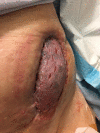Use of negative-pressure wound therapy and split-thickness skin autograft to cover an exposed renal transplant
- PMID: 31540924
- PMCID: PMC6768352
- DOI: 10.1136/bcr-2019-231197
Use of negative-pressure wound therapy and split-thickness skin autograft to cover an exposed renal transplant
Abstract
Exposure of a renal transplant through the abdominal wall is a rare event. A search of the literature reveals only six documented cases which used skin autograft for coverage, with none reported since 1981, and none which used negative-pressure wound therapy (NPWT) to prepare the recipient bed. This case report demonstrates that NPWT followed by split thickness skin graft is a reconstructive option which is feasible in patients who are at high risk for surgical complications in prolonged flap surgery.
Keywords: plastic and reconstructive surgery; renal transplantation; transplantation; urological surgery.
© BMJ Publishing Group Limited 2019. No commercial re-use. See rights and permissions. Published by BMJ.
Conflict of interest statement
Competing interests: None declared.
Figures



References
Publication types
MeSH terms
LinkOut - more resources
Full Text Sources
Medical
